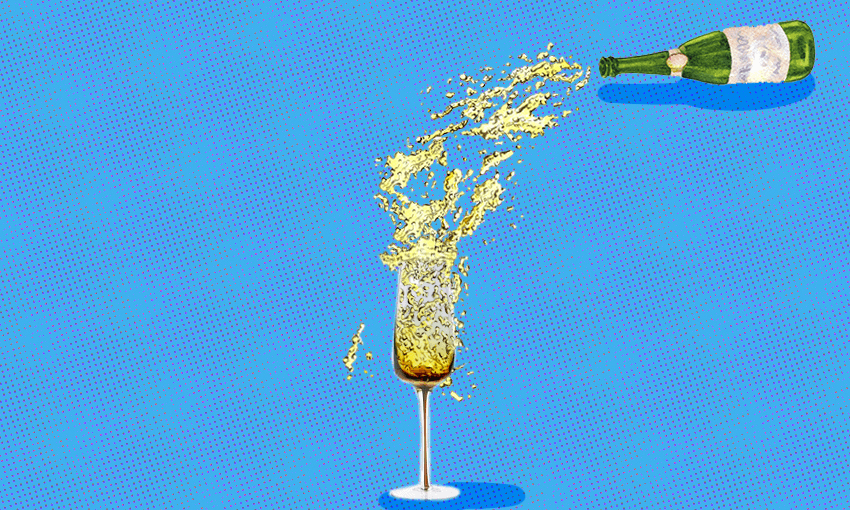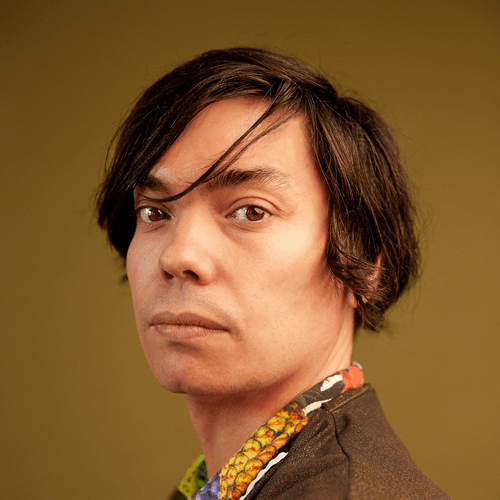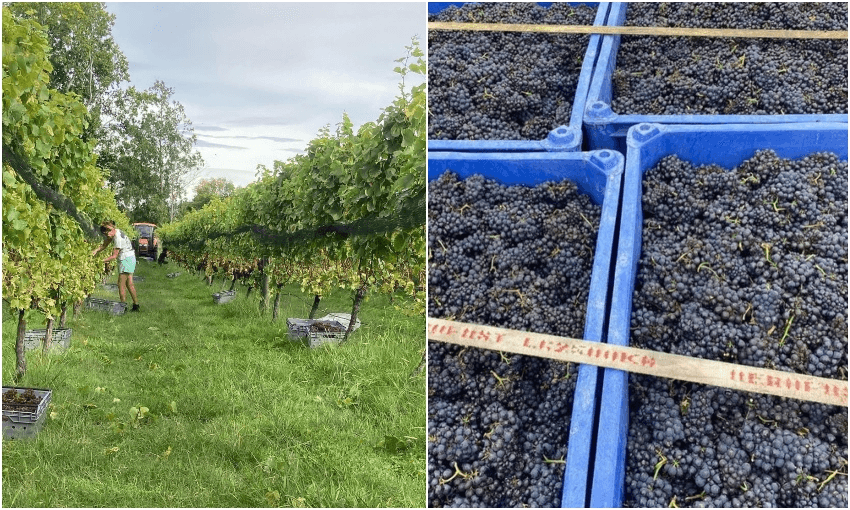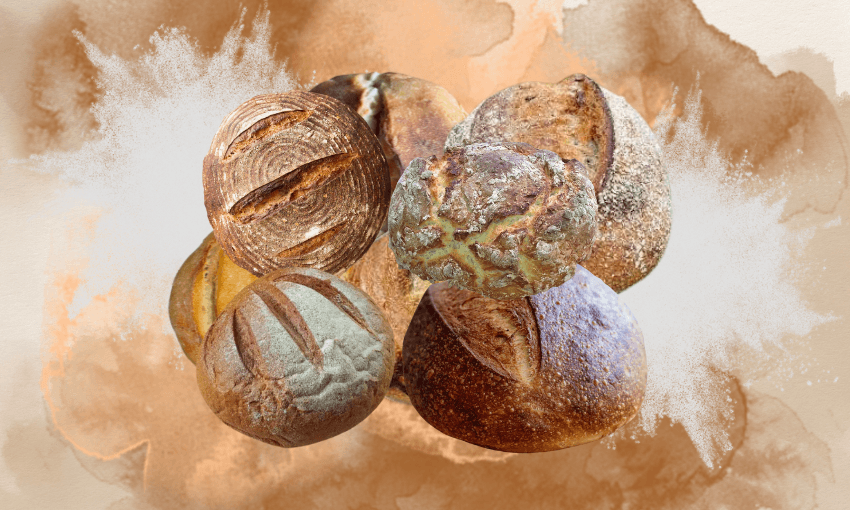Last week, Wellington councillors announced they might be pumping the brakes on the day-drinking trend sweeping your social media: the bottomless brunch. Sam Brooks talked to hospo staff about what it’s like to work one.
“It is talk-compelling. It puts you in a good temper, it makes you satisfied with yourself and your fellow beings, it sweeps away the worries and cobwebs of the week.”
That’s Guy Beringer, way back in 1895, making a strong pitch for the meal we all now know to be brunch. He writes, “By eliminating the need to get up early on Sunday, brunch would make life brighter for Saturday night carousers. It would promote human happiness in other ways as well.”
It’s unlikely Beringer had a bottomless brunch in mind when he wrote that. They’ve been common across the world for years, but it was only in the past few years that the bottomless brunch came to our shores. It’s believed that the first one was at The Lula Inn in Auckland’s Viaduct in 2018, but the concept has since been picked up in restaurants across the country, with over 10 bottomless brunches being held regularly in Auckland alone.
The concept of bottomless brunch is simple: you pay a set fee, usually between $45 and $65, and you’re allowed to drink as many vessels of a select beverage (prosecco and mimosas being the most common) for a set period, usually between 90 minutes and two hours. The price also includes a meal, so it’s not like you can come in and just drink. For the consumer, it’s great value for money.
It’s not without its pitfalls, though. A venue that is unprepared for dozens of groups demanding yet another refill of bubbles can be devastated by these events; the last ever shift at Mr Tom’s on Ponsonby Road was an ill-fated bottomless brunch. You can do a lot of damage to your liver in 90 minutes if you really set your mind to it. This kind of “irresponsible and heavy consumption of alcohol” is what led Wellington’s council to crack down, citing liquor-licensing laws.
So what about the people pouring the drinks, mixing the mimosas, and making sure that punters can still walk out of the bar in a straight line?
Yeah, it’s not all sunshine and Bolly.
“Brunch was the shittiest shift to work.”
I spoke to a few hospitality workers who have worked bottomless brunch shifts across Auckland, and the consensus has been that it’s a rough assignment, often busier than even a Friday or Saturday night.
One hospo worker worked the first ever bottomless brunch shift in the country: at The Lula Inn in 2018. He says, “The whole purpose was to stand out. It was a gimmick. It was fun to work those early shifts, because it was super manageable and people were really excited to be there, and because they weren’t in a room of people doing it, they weren’t feeding off each other.”
The Viaduct-based bar started its bottomless brunch small, with just one section of the venue, requiring three waitstaff, a manager, and an extra bartender. They figured out the processes, and as it got more popular, the brunch extended past the one section until it became what it is today: an entire venue running several sittings of bottomless brunch over the weekend. The venue ended up having more staff on brunch shifts than a Friday or a Saturday night.
As well as being first, The Lula Inn’s bottomless brunch is now the most famous, with its highly Instagrammable fern wall serving as the backdrop to many photos. As it expanded, they had to introduce rules, but nothing particularly restrictive, says the staff member. For example, if the staff saw a customer sculling their drink, they would wait 15 minutes before topping you up. Similarly, the staff would shift the ratio of prosecco to orange juice in the mimosas; people might be drinking more liquid, but actually end up drinking less alcohol.
It’s the sheer volume of the bottomless brunch that seems overwhelming, though. Venues go through hundreds of bottles of prosecco a weekend, and this worker estimates he made “four or five thousand espresso martinis” during his time at the venue over a few years. He says, “I remember standing there opening hundreds of bottles of prosecco and my hands being slashed from all the foil. At the end of it, you realise you’ve got about 300 cuts running down your hand in the same direction. You wouldn’t notice until you squeezed a lime later on.”
Another worker who spoke to The Spinoff was a waiter at that infamous final shift at Mr Tom’s. The event, reported on by both the Herald and Stuff, sounded like complete carnage, with people walking out without receiving food, two chefs having a fight, and glasses being broken. The worker confirms it: “I worked that shift and it was the most ridiculous thing I’ve ever seen in my life in all my hospo years. It was honestly madness.”
Previous bottomless brunch shifts at Mr Tom’s could be just as hectic, though.“I remember this girl passed out in our blanket bin, and I had to deal with that while the rest of the table didn’t care and continued sculling. I told them, “One of your friends has passed out. Can one of you get her a taxi?”
“People would stumble out, leave and try to go to Chapel, and they would throw up in the garden outside.”
It might be hard on the staff, but according to our sources, it’s not exactly a winner for the venues either. Another worker we spoke to was a bartender at an Asian fusion restaurant (now closed) that ran a slightly higher end bottomless brunch, with prosecco and beer on tap, plus a meal, for $70. “From a business perspective it looked like an easy sell, but it didn’t work,” he said. “For example, their meals were bottomless dumplings that were high end in terms of quality, cost and prep – it was roughly $16 for four dumplings – and we were selling them bottomlessly. We were pissing money away.”
“I remember looking at the sous chef and thinking he was going to cry every bottomless brunch, because it was all of his work being given away, at a loss. This big Australian bloke came in, and he must’ve had $100 worth of beer, and $200 worth of dumplings.”
The workers I spoke to insisted it’s not all bad, as long as the spirit of the thing is adhered to: it’s not about drinking as much as possible, it’s about having a nice time with your mates on the cheap. The first worker I spoke to, from The Lula Inn, explains how this spirit has morphed over the years, as the concept has spread across venues attracted by the success of the initial one (especially as a branding exercise). “People see it as a way for getting fucked up for cheap, which is what it was not meant to be originally. A lot of other venues fell into that trap but they started with their whole venue.
“We knew that we wouldn’t handle the whole venue off the bat, so we started small and scaled it up, building our processes along the way. So all these venues go, “Fuck yeah, bottomless brunch!” and the staff don’t know how to manage it.”
The Mr Tom’s worker said many of the groups who came in were often no bother; the boozy stag dos and the entitled yo-pros were the exception, not the rule. “We had this little hen’s party come in and one of them was pregnant, and they were calm and chill. When it was done properly, it was a really fun thing, but it was just too many people taking the piss.”
Literally, it seems.






